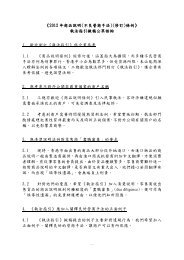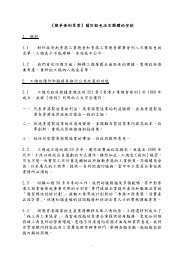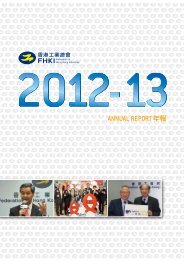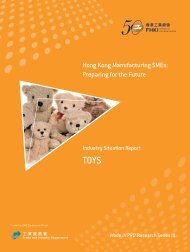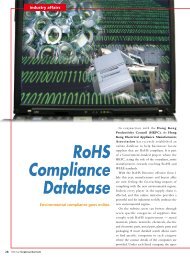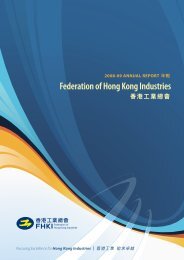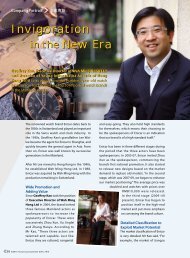Hong Kong Manufacturing SMEs: Preparing for the Future
Hong Kong Manufacturing SMEs: Preparing for the Future
Hong Kong Manufacturing SMEs: Preparing for the Future
- No tags were found...
You also want an ePaper? Increase the reach of your titles
YUMPU automatically turns print PDFs into web optimized ePapers that Google loves.
58The Guangdong Government also published its own“Plan on Adjusting and Revitalising <strong>the</strong> Electronicsand In<strong>for</strong>mation Industry” in November 2009. 120The Plan focuses on industrial restructuring andupgrading, and governmental support is focusedon pillar sectors, leading enterprises, and <strong>the</strong>development of self-owned technology and brands.Fur<strong>the</strong>r, <strong>the</strong> timeframe <strong>for</strong> <strong>the</strong> “home appliance andmotor vehicles to <strong>the</strong> countryside” and <strong>the</strong> “motorvehicle and home appliance replacement” policieshave been fur<strong>the</strong>r extended. 121These policiescategorise certain consumer electronic productssuch as televisions and telephones as homeappliances and eligible <strong>for</strong> support. These policieswill stimulate <strong>the</strong> demand in China <strong>for</strong> consumerelectronics and <strong>Hong</strong> <strong>Kong</strong> firms will want to bepositioned to take advantage.Labour issues are compounded by <strong>the</strong> fact thatconsumer electronics manufacturing requiresa large number of skilled technicians and <strong>the</strong>number of migrant workers looking <strong>for</strong> work in<strong>the</strong> PRD, especially skilled technicians, has fallensince 2008. The Labour Contract Law will increasemanufacturing costs because of <strong>the</strong> requirementthat firms provide additional worker benefits. Thiswill have <strong>the</strong> greatest impact on labour intensiveindustries, meaning that <strong>the</strong> effect on <strong>the</strong> consumerelectronics sector is likely to be less pronouncedthan on many o<strong>the</strong>rs, 122 but firms will still need tocover any additional cost and <strong>the</strong>y will need to be ina position to source skilled workers on an ongoingbasis.120 www.uschina.org.121 The initial “Home appliance replacement” policy expired on31 May 2010 and has been extended until 31 December 2011.122 China Statistical Yearbook 2009, calculated ratio of GIO toEmployment.123 Ministry of Commerce, 2007124 The opinions on general planning and management <strong>for</strong><strong>the</strong> highly polluting industries such as electroplating,printing, and dyeing”, Guangdong Environmental ProtectionDepartment, 2008125 Interview with <strong>the</strong> <strong>Hong</strong> <strong>Kong</strong> Electronics Industry Council,14 April 2010.The consumer electronics sector does not haveany export processing restrictions directly imposedon it but <strong>the</strong> supply chain <strong>for</strong> non ferrous metalsis affected by restrictions on copper, aluminium,nickel, tin, and zinc products. 123 The export rebate<strong>for</strong> <strong>the</strong> sector did not change in 2007 or since. Theupstream electroplating of components and <strong>the</strong>manufacture of circuit boards used in <strong>the</strong> sectorare polluting activities that are under close scrutinyand control, and are being restricted. In 2008, <strong>the</strong>Guangdong Environmental Protection Bureau issueda plan 124 to consolidate all electroplating factoriesto purpose-built parks with <strong>the</strong>ir own centralisedwater purifying centres so that all discharges can becontrolled. Factories that fail to move will be closeddown. These activities have <strong>the</strong> potential to disrupt<strong>the</strong> sector by disrupting <strong>the</strong> supply chain.Response Strategies of <strong>Hong</strong> <strong>Kong</strong> <strong>SMEs</strong><strong>Hong</strong> <strong>Kong</strong> electronics firms understand thatcompetition in <strong>the</strong> industry is cost-based to an extentand that cost increases must be managed throughimproved operating efficiencies, but <strong>the</strong> precision thatis required in doing <strong>the</strong> manufacturing means that itis a combination of price, quality, and per<strong>for</strong>mancethat actually determines which firms get orders andwhich firms do not. Most successful <strong>Hong</strong> <strong>Kong</strong>firms are committed to doing well across all of <strong>the</strong>seattributes in order to cope with competition fromboth Chinese firms at <strong>the</strong> low-end and Japanese,Korean, and Taiwan firms at <strong>the</strong> higher-end. 125Many <strong>Hong</strong> <strong>Kong</strong> electronics firms do <strong>the</strong>irmanufacturing in Guangdong which is cheaperthan doing it in <strong>Hong</strong> <strong>Kong</strong>, but more expensivethan manufacturing in some o<strong>the</strong>r parts of China.However, as <strong>the</strong>se firms point out, making productsin Guangdong means that <strong>the</strong> end product is stillrelatively high in quality, so some firms in <strong>the</strong> sectorhave <strong>for</strong> <strong>the</strong> time being strategically accepted apresence in Guangdong as being a necessary tradeoffnoting that controlling cost is only one issue thatneeds to be managed. In response to <strong>the</strong> economicdownturn, many firms in <strong>the</strong> electronics industrytried to cut costs by reducing production or bylaying off workers.




